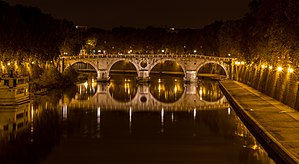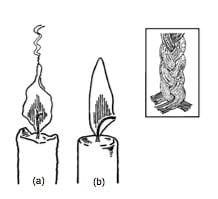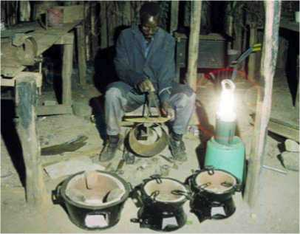
Lighting or illumination is the use of light for improving visibility at night. Lighting includes the use of both artificial light sources (ie lamps), as well as natural illumination by capturing daylight (ie using windows, skylights (sometimes makeshift with soda bottles).
What is light?[edit | edit source]
Light is electromagnetic radiation; the human eye is sensitive to a spectrum with visible colours as seen in a rainbow. When these colours are mixed they appear as white light. More energy is present in the light of the upper or violet/blue end of the spectrum than at the red end. Therefore, more energy is generally necessary to produce the blue-violet component needed to produce what to the eye appears as white light. Therefore the quality of light (in colour terms) influences the energy requirement; if colour does not matter then it is at least theoretically more efficient to use a red or orange light, and this in fact is common practice in the case of street lighting where the most energy-efficient lights are used, namely orange/yellow sodium lights. Clearly, for domestic purposes there is merit in paying something extra to achieve a white, or near-white light.
Light intensity, or illuminating power of a light source in any one direction is commonly defined in candela, which although it has a rigorous scientific definition, for practical purposes can be thought of as 'candle-power'; i.e. the output from a standard paraffin-wax candle. The rate at which light is emitted is measured in lumens, which are defined as the rate of flow of light from a light source of one candela through a solid angle of one steradian. A more easily understood approximation of this would be to imagine a one candela candle at the apex of a conical lampshade with its sides sloping at about 70 degrees to each other; the conical beam emitted, diverging at about 70 degrees, would be about one lumen.
Methods of providing light[edit | edit source]
There are two main physical principles by which light may be produced:
- incandescent
- fluorescent
The incandescent principle depends on heating a source to a temperature in the region of 2000, 4000 or 6000°C to obtain reddish, yellowish or white light, respectively. Typical examples are candles and lamps utilising a bright flame (where white hot or incandescent particles of carbon in the flame produce the light) and incandescent filament light bulbs where a fine coil of tungsten wire is heated (in a vacuum or inert low pressure gas to prevent the filament oxidising or burning) by an electric current passing through it. All incandescent light sources, whether flames or electrically heated filaments, tend to produce more heat than light and are therefore relatively inefficient in the rate of conversion of energy to light.
Fluorescence occurs under certain conditions when a material can be made to glow with a 'cold light'. Fluorescence is a phenomenon in which the atoms of a gas, vapour or solid are excited in such a way that they emit light. In some cases such as sodium and mercury vapour discharge lamps (used commonly for street lighting) vapour in a glass tube emits the light. In other cases such as the commonly used fluorescent tube lights, ultraviolet light, which is invisible to the eye, is emitted by exciting mercury vapour atoms within the tube, and this in turn causes a white translucent coating in the tube to fluoresce with a whitish light.
In other words, the coating converts invisible ultraviolet light into visible white (or near-white) light. Most fluorescent processes involve some expenditure of electrical energy, so they are accompanied by the production of some heat. (Non-electrical fluorescence is used where the mantles of pressure lamps and gas lamps are heated and emit a much brighter and whiter light than would occur simply as a result of their temperature.)
For practical purposes, the options for lighting reduce generally either to lamps that run on fuels, or electric lights. Table 1 indicates the options and their relative lighting capability.
| Type of light | Energy source | Intensity (lumens) | Efficiency (lumen/W) |
|---|---|---|---|
| Candle | Paraffin wax | 1 | .01 |
| Oil lamp (wick) | Kerosene | 1-10 | .01-.1 |
| Hurricane lamp (wick) | Kerosene | 10-100 | .1-.2 |
| Oil lamp (mantle) | Kerosene | 1000 | 1 |
| Gas lamp (mantle) | 1 .p.g (eg butane) | 1000 | 1 |
| Filament lamp 3W | Electricity | 10 | 3 |
| Filament lamp 40W | Electricity | 400 | 10 |
| Filament lamp 100W | Electricity | 1300 | 13 |
| Fluorescent 15W | Electricity | 600 | 40 |
| Fluorescent 30W | Electricity | 1500 | 50 |
| Mercury 80W | Electricity | 3200 | 40 |
| Sodium sox 35W | Electricity | 4500 | 128 |
More important to the user than the efficiency in lumen/watt is the cost per lumen. Kerosene and candle wax are cheaper sources of watts than any form of electricity, and this partially makes up for their inefficiency, but not for their poor quality light (wicks) or the amount of heat. Kerosene lamps produce better light, but they are unpleasantly noisy and uncomfortably hot to be near in a tropical climate; they also use much more fuel than wick lamps, and are troublesome to start. Cylinder gas lights provide a slightly more expensive but convenient alternative.
Artificial light[edit | edit source]
These include fuel-based lighting and electric lighting methods. Fuel-based lighting is often far less energy efficient than combusting (bio)fuel in a gen-set and using the electricity of this gen-set to power a electric device such as a lamp (even incandescents, and definitely using compact fluorescent lights, LED lighting or LEC lighting.W[verification needed]
That said, fuel-based lighting can be much cheaper as a short term solution owing to the set-up costs of an electricity infrastructure (whether grid power or a small scale setup of a solar panel and a battery). Poor people in the majority world hence often stick to fuel-based lighting methods. These create a lot of smoke, the amount depending on the method and fuel used, and the resulting indoor air pollution has serious negative impacts on health - causing eye and respiratory illness in particular.
Candlemaking[edit | edit source]

In many parts of the world, candles provide the main source of light, other than daylight. They have a number of advantages in that they are relatively cheap, self-contained and portable and can thus be used when or where other kinds of lighting are unavailable. This Technical Brief describes the essential materials used in candlemaking and outlines the main processes of small-scale manufacture.
Rural lighting[edit | edit source]

Lighting is taken for granted in industrial countries and in many urban areas of developing countries. It is hard for many people to imagine living at night without being able to obtain light at the flick of a switch. However, about half of humanity, over 2500 million people, live without much light after sunset, since they do not have access to grid-connected electricity.
Lighting in the rural areas of developing countries is generally provided by candles or kerosene lamps, while torches (or flash-lights) powered by expensive, throw-away dry-cells are used as a portable source of light for intermittent use. All combustion lamps pose a real fire risk. Kerosene and butane are also becoming increasingly expensive and are sometimes in short supply in developing countries. Therefore the rest of the technical brief addresses the use of electric lighting in rural 'off-grid' locations.